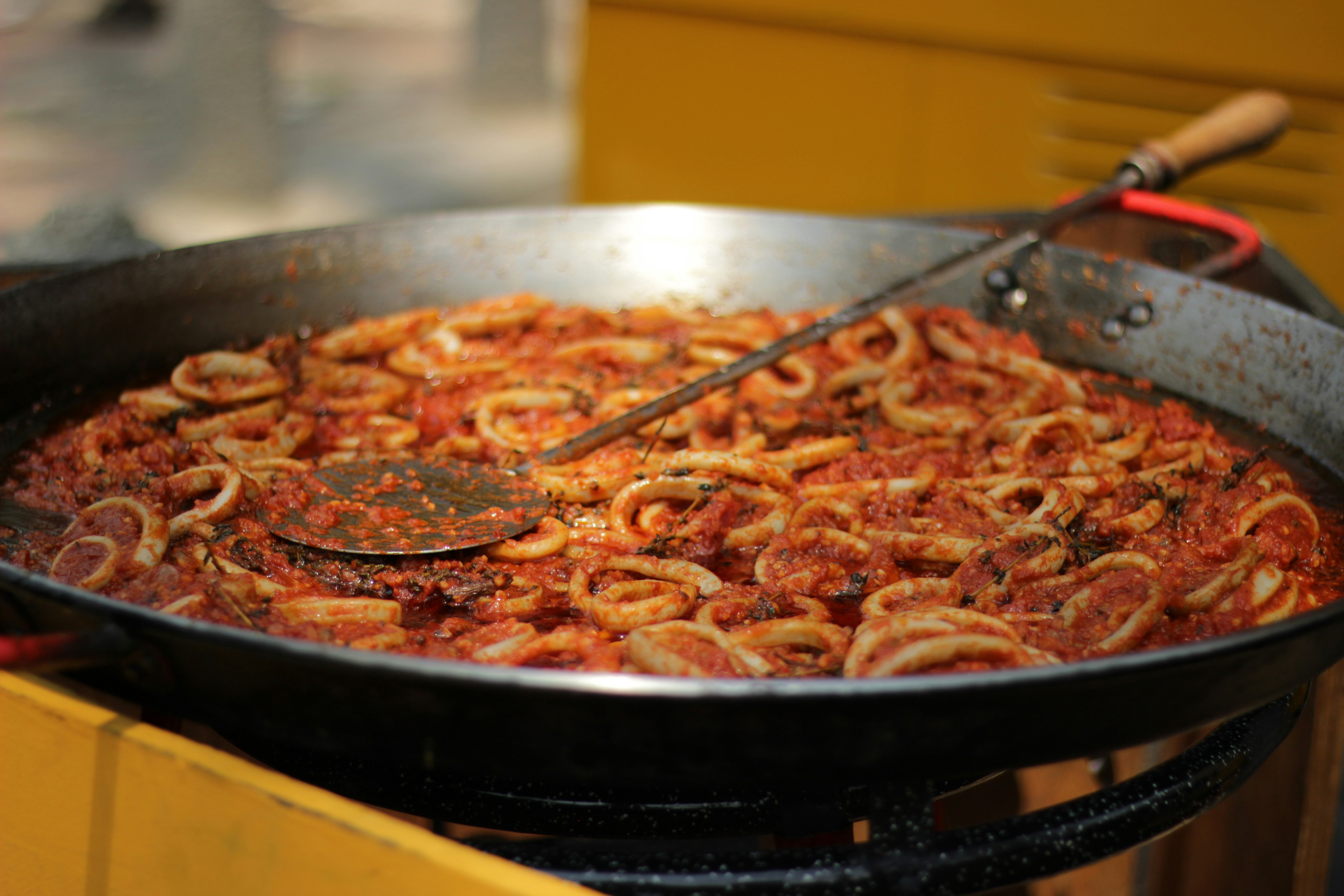What is Calamariere?
The term calamariere finds its roots in the Italian word calamari, which directly translates to squid. This fascinating word not only references the beloved marine cephalopod but also reveals the rich linguistic tapestry inherent in Italian and other Mediterranean languages. The suffix “-iere” is often employed in Italian to denote a profession or a role, suggesting that a calamariere could signify various individuals connected to squid, ranging from vendors and chefs to servers and culinary experts.
In a broader context, the calamariere may be a person whose expertise in preparing or selling squid-based dishes highlights the importance of this ingredient in Mediterranean gastronomy. Linguistic variations across Mediterranean regions may introduce different roles or nuances associated with the term. For example, in some dialects, a vendor selling calamari might be recognized with a unique title, emphasizing their regional cultural significance. This interplay between the root word and its suffix inspires a greater appreciation for squid and its culinary versatility.
Moreover, the concept of calamariere invites culinary enthusiasts to explore squid dishes in various contexts. From street food stalls offering crispy fried calamari to upscale restaurants presenting sophisticated squid delicacies, the roles related to squid preparation and presentation are diverse and essential to Mediterranean cuisine. As such, understanding the term calamariere provides a glimpse into the vibrant world of marine culinary arts and the cultural practices surrounding the consumption of squid.
The Culinary Significance of Calamari
Calamari, a beloved delicacy in Mediterranean cuisine, holds a prominent place in the culinary landscape due to its versatility and myriad cooking methods. This seafood, typically derived from various species of squid, is not only a staple dish across many regional cuisines but also a feature of diverse culinary traditions. From coastal towns to bustling city markets, calamari is cherished for its ability to adapt to various flavors and preparations, making it integral to the Mediterranean diet.
One of the defining characteristics of calamari is its adaptability in cooking techniques. Whether it is grilled, fried, boiled, or included in stews, calamari can be prepared in numerous ways, each enhancing its unique taste and texture. For instance, calamari rings are often lightly battered and fried to achieve a crispy exterior that contrasts beautifully with its tender, succulent insides. Alternatively, the Mediterranean method of grilling calamari with olive oil, garlic, and fresh herbs allows the natural flavors to shine, resulting in a dish that highlights the seafood’s freshness.
Traditional recipes utilizing calamari exemplify its culinary significance. Dishes such as calamari alla griglia (grilled squid) or calamari ripieni (stuffed squid) showcase the ingredient’s compatibility with various regional accompaniments, such as tomatoes, olives, and citrus. These preparations not only enhance the flavors of calamari but also reflect the local ingredients available, thus promoting sustainability and seasonal eating.
Furthermore, calamari is often paired with a variety of sides—from fresh salads to hearty pasta—which further accentuates its role in Mediterranean dining. The ability of calamari to harmonize with diverse ingredients speaks to its position as a cherished component in numerous culinary traditions. Indeed, calamari is not just a meal; it is a cultural experience that celebrates the richness of Mediterranean cuisine.
Roles and Specializations of a Calamariere
The profession of calamariere encompasses a variety of roles associated with the procurement, preparation, and presentation of squid cuisine. From vendors who sell fresh squid in bustling markets to chefs who create exquisite dishes featuring this versatile seafood, each role plays a crucial part in the appreciation and promotion of calamari and its culinary applications.
Vendors who specialize in fresh squid, often found in coastal regions, must possess a keen understanding of the quality and freshness indicators of calamari. Their expertise allows them to select and source the best specimens from local fishermen or fish markets, ensuring that consumers receive a premium product. These vendors not only sell the calamari but are also instrumental in educating customers about optimal cooking methods, storage techniques, and recipe suggestions, contributing to the culinary culture surrounding squid.
Chefs, on the other hand, take the ingredients provided by these vendors and elevate them into remarkable dishes. Specialization in squid cuisine requires a blend of technical skills and creative flair, as calamari can be prepared in myriad ways, from grilling and frying to stuffing and stewing. A successful chef must have a deep understanding of flavor profiles, cooking times, and presentation, as they aim to highlight the natural taste of calamari while innovating traditional recipes. Moreover, chefs often collaborate with calamariere vendors to ensure that they are using the freshest squid, an integral aspect of their cooking success.
These roles hold cultural significance in Mediterranean societies, where squid is a staple ingredient in many regional dishes. The connection between calamariere vendors and chefs creates a culinary ecosystem that fosters appreciation for local seafood, while also supporting sustainable fishing practices. As they work in tandem, their shared passion for calamari enhances the Mediterranean gastronomic landscape.
Common Calamari Dishes Around the World
Calamari, known for its tender texture and subtle flavor, features prominently in various global cuisines, showcasing the versatility of this seafood delicacy. One of the most recognized preparations is fried calamari, where the squid is battered and deep-fried, often served as an appetizer with a side of marinara sauce. This dish is especially popular in Mediterranean countries, where it epitomizes the casual dining experience by pairing well with drinks and social gatherings.
Another notable dish is the calamari salad, which is celebrated for its refreshing qualities. This preparation often includes grilled or poached calamari combined with a variety of vegetables, citrus dressings, and a hint of herbs. Mediterranean nations, particularly Greece and Italy, have their unique takes on the salad, incorporating local ingredients such as olives, capers, and a drizzle of olive oil, transforming calamari into a vibrant centerpiece of the meal.
Moreover, the culinary landscape of Asia has also embraced calamari, with variations that often complement bold flavors and spices. For instance, in Japanese cuisine, calamari may be found in sushi rolls or served as a grilled dish infused with teriyaki or wasabi. In Southeast Asia, calamari can be cooked in a spicy curry or stir-fried with vegetables, exemplifying how the ingredient adapts beautifully to regional tastes.
In Latin America, calamari is often featured in ceviche, where raw squid is marinated in citrus juices, allowing the acidity to “cook” the fish, resulting in a zesty and flavorful dish. Each of these preparations highlights the global appeal of calamari, showcasing how different cultures creatively adapt this seafood to reflect their culinary traditions. The popularity of calamari dishes continues to grow, and it invites culinary exploration and experimentation across various cuisines.
The Health Benefits of Calamari
Calamari, known for its tender texture and distinctive flavor, is not only a culinary delight but also offers a range of health benefits that make it an appealing option for health-conscious eaters. Rich in various essential nutrients, this seafood adds significant value to a balanced diet. A typical serving of calamari provides a robust profile of macronutrients, including protein, healthy fats, and carbohydrates, making it a satiating choice that supports muscle growth and repair.
Protein is a key component of calamari, with approximately 15 grams found in a three-ounce serving. This high-quality protein is particularly beneficial for those seeking to build muscle or maintain lean body mass. Additionally, calamari is relatively low in calories, making it suitable for those managing their weight. When prepared healthily, calamari can be a flavorful alternative to other high-calorie protein sources.
Beyond macronutrients, calamari also serves as an excellent source of vitamins and minerals. It is rich in vitamin B12, which plays a vital role in energy production and the maintenance of healthy nerve cells. Furthermore, this seafood is a significant source of selenium and zinc, two minerals that are crucial for immune function, antioxidant protection, and overall health. The presence of omega-3 fatty acids in calamari contributes to heart health by promoting lower blood pressure and cholesterol levels.
Incorporating calamari into your diet can lead to various health benefits, including improved cardiovascular health and enhanced immune function. Whether grilled, fried, or included in salads, calamari provides a delicious way to boost nutrient intake while enjoying an adventurous culinary experience. By embracing this versatile seafood, individuals can diversify their meals and make informed dietary choices that positively impact their well-being.
Sustainable Calamari Fishing Practices
The practice of calamari fishing has garnered significant attention in recent years, particularly due to the environmental concerns associated with overfishing. Sustainable fishing practices are critical to ensure the health of squid populations and the broader marine ecosystems in which they reside. Overfishing can lead to a depletion of not only calamari but also negatively impact the biodiversity of the ocean, disrupting food chains and habitats.
To address these pressing issues, many fisheries are adopting sustainable fishing practices. These methods include setting quotas that restrict the amount of calamari that can be harvested within a certain period, ensuring that populations can regenerate. Additionally, the implementation of size limits helps protect juvenile squid, allowing them to mature and reproduce before being caught. Furthermore, many fisheries are now prioritizing selective fishing techniques that minimize the capture of non-target species, reducing bycatch and promoting ecological balance in marine environments.
Technological advancements have also contributed to the sustainability of calamari fishing. The use of more sophisticated monitoring systems allows for real-time tracking of squid populations, enabling fisheries to adjust their practices based on current data. This proactive approach helps ensure that calamari is harvested in a manner that maintains population stability and ecological integrity. Additionally, certification programs, such as those offered by the Marine Stewardship Council (MSC), provide consumers with options to choose calamari sourced from fisheries that adhere to sustainable practices.
As demand for calamari increases worldwide, it is imperative for consumers to consider the sources of their seafood. Supporting sustainable calamari practices not only helps preserve squid species but also protects marine ecosystems for future generations. By making informed choices, we can contribute to the long-term viability of calamari and the oceans that host these remarkable creatures.
The Art of Cooking Calamari
Cooking calamari, a versatile seafood enjoyed in various cuisines, requires a delicate balance of technique and timing to achieve the perfect texture. The primary challenge lies in ensuring that it does not become rubbery. To avoid this common mistake, it is crucial to cook calamari quickly, either by sautéing, grilling, or frying for only a few minutes. When cooked just right, calamari should be tender and flavorful, embodying the unique qualities that make it a favored ingredient.
To begin, proper preparation of calamari is essential. Start by cleaning the squid thoroughly if using whole calamari. Remove the innards and the transparent quill, then rinse well under cold water. Cutting the squid into rings or leaving it whole for grilling can vary cooking times but requires the same attention to timing. A quick blanching in boiling water for a minute can also help to firm up the texture before proceeding with your preferred cooking method.
Enhancing the flavor of calamari can be achieved through marinades or seasoning. Common ingredients include garlic, lemon juice, olive oil, and herbs such as parsley or oregano. Allowing calamari to marinate for at least 30 minutes not only infuses it with flavor but also helps to further tenderize the meat. When grilling, a sprinkle of salt and pepper can be sufficient, while frying might benefit from a light dusting of flour or breadcrumbs for added texture.
Ultimately, experimenting with various spices and cooking methods will help to find a personal preference. From classic approaches inspired by Mediterranean cuisine to more contemporary preparations, calamari can be a canvas for a world of flavors. By avoiding common pitfalls and focusing on technique, home cooks can master the art of preparing calamari, delighting both themselves and their guests.
Cultural Celebrations Featuring Calamari
Calamari, the culinary term for squid, is not only cherished for its delectable taste but also for its significant role in various cultural celebrations around the globe. From Mediterranean coasts to the bustling markets of Japan, calamari has cemented its place in local traditions, often featured at festivals dedicated to seafood and community bonding.
In Italy, the Feast of Saint Peter is a vibrant celebration, especially prominent in coastal towns like San Benedetto del Tronto. Here, calamari often takes center stage, prepared in various forms, including fried, grilled, and stuffed, reflecting the local culinary artistry. These festivals showcase the unity of communities as families and friends gather to enjoy seafood delicacies, emphasizing the social aspect of dining.
Similarly, the annual Festa del Mare in Sicily celebrates the rich maritime heritage of the region. This festival features a plethora of seafood dishes, with calamari being a star attraction. Visitors indulge in traditional recipes, while local fishermen exhibit their skills in squid-catching techniques, reinforcing the connection between gastronomic traditions and local livelihoods. The event not only highlights the culinary delights associated with calamari but also fosters a sense of pride within the community.
On the other side of the world, Japan’s summer festivals, or ‘matsuri’, often include stalls offering grilled calamari on skewers, a favorite among festival-goers. These gatherings exemplify the importance of seafood in Japanese cuisine, where calamari is enjoyed as part of a larger celebration of life, culture, and tradition. Such festivities enrich community ties and provide opportunities to sample culinary delights in a lively atmosphere.
Through these various cultural celebrations, calamari serves not just as a dish but as a symbol of community, tradition, and delight in culinary arts around the world. The enjoyment of calamari highlights its ability to bring people together, fostering connections that span generations.
Future Trends in Calamari Cuisine
As the culinary landscape continues to evolve, so too does the approach to calamari, a beloved seafood delicacy enjoyed around the globe. One of the most notable trends in calamari preparation is the embrace of innovative cooking techniques. Chefs are increasingly utilizing methods such as sous-vide and char-grilling, delivering tender and flavorful dishes while preserving the delicate texture of the squid. The rising popularity of these cooking styles not only enhances the taste of calamari but also allows for greater creativity in flavor pairings and presentation.
Another noteworthy aspect of calamari’s future lies in the fusion of global cuisines. Chefs are drawing inspiration from diverse culinary traditions, combining local flavors with traditional calamari dishes. For instance, incorporating Asian spices and sauces or Mediterranean herbs can infuse new life into calamari dishes, appealing to adventurous consumers seeking unique dining experiences. Through this culinary hybridity, restaurants can capture the attention of an increasingly diverse customer base, enhancing the overall enjoyment of calamari.
Furthermore, the inclusion of calamari in gourmet dining continues to grow, as chefs aim to elevate this humble seafood to fine dining status. Renowned chefs are experimenting with presentations that highlight the artistry of calamari, transforming it into visually stunning and intricately prepared dishes. This trend reflects a wider cultural shift towards appreciating the complexities of seafood, where calamari is no longer viewed merely as an appetizer, but as a main feature worthy of being celebrated.
However, it is essential to consider external factors that may affect calamari’s availability, such as climate change. Changes in ocean temperatures and habitats can impact squid populations, potentially leading to shortages or shifts in sourcing. The culinary world will need to adapt accordingly, finding sustainable practices and alternative sources to ensure that calamari remains a staple on menus worldwide. By addressing these challenges, the future of calamari cuisine looks bright, continuing to delight seafood lovers through innovation and sustainability.







